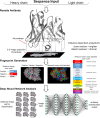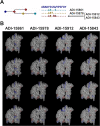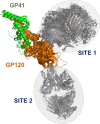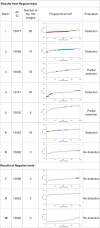Using the antibody-antigen binding interface to train image-based deep neural networks for antibody-epitope classification
- PMID: 33780441
- PMCID: PMC8032195
- DOI: 10.1371/journal.pcbi.1008864
Using the antibody-antigen binding interface to train image-based deep neural networks for antibody-epitope classification
Abstract
High-throughput B-cell sequencing has opened up new avenues for investigating complex mechanisms underlying our adaptive immune response. These technological advances drive data generation and the need to mine and analyze the information contained in these large datasets, in particular the identification of therapeutic antibodies (Abs) or those associated with disease exposure and protection. Here, we describe our efforts to use artificial intelligence (AI)-based image-analyses for prospective classification of Abs based solely on sequence information. We hypothesized that Abs recognizing the same part of an antigen share a limited set of features at the binding interface, and that the binding site regions of these Abs share share common structure and physicochemical property patterns that can serve as a "fingerprint" to recognize uncharacterized Abs. We combined large-scale sequence-based protein-structure predictions to generate ensembles of 3-D Ab models, reduced the Ab binding interface to a 2-D image (fingerprint), used pre-trained convolutional neural networks to extract features, and trained deep neural networks (DNNs) to classify Abs. We evaluated this approach using Ab sequences derived from human HIV and Ebola viral infections to differentiate between two Abs, Abs belonging to specific B-cell family lineages, and Abs with different epitope preferences. In addition, we explored a different type of DNN method to detect one class of Abs from a larger pool of Abs. Testing on Ab sets that had been kept aside during model training, we achieved average prediction accuracies ranging from 71-96% depending on the complexity of the classification task. The high level of accuracies reached during these classification tests suggests that the DNN models were able to learn a series of structural patterns shared by Abs belonging to the same class. The developed methodology provides a means to apply AI-based image recognition techniques to analyze high-throughput B-cell sequencing datasets (repertoires) for Ab classification.
Conflict of interest statement
The authors have declared that no competing interests exist.
Figures














Similar articles
-
Prediction of Paratope-Epitope Pairs Using Convolutional Neural Networks.Int J Mol Sci. 2024 May 16;25(10):5434. doi: 10.3390/ijms25105434. Int J Mol Sci. 2024. PMID: 38791470 Free PMC article.
-
Opening up the blackbox: an interpretable deep neural network-based classifier for cell-type specific enhancer predictions.BMC Syst Biol. 2016 Aug 1;10 Suppl 2(Suppl 2):54. doi: 10.1186/s12918-016-0302-3. BMC Syst Biol. 2016. PMID: 27490187 Free PMC article.
-
Bi-channel image registration and deep-learning segmentation (BIRDS) for efficient, versatile 3D mapping of mouse brain.Elife. 2021 Jan 18;10:e63455. doi: 10.7554/eLife.63455. Elife. 2021. PMID: 33459255 Free PMC article.
-
Revolutionizing Synthetic Antibody Design: Harnessing Artificial Intelligence and Deep Sequencing Big Data for Unprecedented Advances.Mol Biotechnol. 2025 Feb;67(2):410-424. doi: 10.1007/s12033-024-01064-2. Epub 2024 Feb 3. Mol Biotechnol. 2025. PMID: 38308755 Review.
-
The rise of big data: deep sequencing-driven computational methods are transforming the landscape of synthetic antibody design.J Biomed Sci. 2024 Mar 16;31(1):29. doi: 10.1186/s12929-024-01018-5. J Biomed Sci. 2024. PMID: 38491519 Free PMC article. Review.
Cited by
-
Advances in antibody discovery from human BCR repertoires.Front Bioinform. 2022 Oct 20;2:1044975. doi: 10.3389/fbinf.2022.1044975. eCollection 2022. Front Bioinform. 2022. PMID: 36338807 Free PMC article. Review.
-
Structure-Based Epitope Profiling with the Structural Profiling of Antibodies to Cluster by Epitope 2 (SPACE2) Algorithm.Methods Mol Biol. 2025;2937:261-274. doi: 10.1007/978-1-0716-4591-8_16. Methods Mol Biol. 2025. PMID: 40593426
-
RESP2: An uncertainty aware multi-target multi-property optimization AI pipeline for antibody discovery.bioRxiv [Preprint]. 2025 Mar 9:2024.07.30.605700. doi: 10.1101/2024.07.30.605700. bioRxiv. 2025. PMID: 39131296 Free PMC article. Preprint.
-
Progress and challenges for the machine learning-based design of fit-for-purpose monoclonal antibodies.MAbs. 2022 Jan-Dec;14(1):2008790. doi: 10.1080/19420862.2021.2008790. MAbs. 2022. PMID: 35293269 Free PMC article. Review.
-
Improved computational epitope profiling using structural models identifies a broader diversity of antibodies that bind to the same epitope.Front Mol Biosci. 2023 Sep 18;10:1237621. doi: 10.3389/fmolb.2023.1237621. eCollection 2023. Front Mol Biosci. 2023. PMID: 37790877 Free PMC article.
References
-
- Dati F, Schumann G, Thomas L, Aguzzi F, Baudner S, Bienvenu J, et al.. Consensus of a group of professional societies and diagnostic companies on guidelines for interim reference ranges for 14 proteins in serum based on the standardization against the IFCC/BCR/CAP Reference Material (CRM 470). International Federation of Clinical Chemistry, Community Bureau of Reference of the Commission of the European Communities, College of American Pathologists. Eur J Clin Chem Clin Biochem 1996; 34(6):517–20. ed2020. - PubMed
-
- Briggs AW, Goldfless SJ, Timberlake S, Belmont BJ, Clouser CR, Koppstein D, et al.. Tumor-infiltrating immune repertoires captured by single-cell barcoding in emulsion. bioRxiv [Preprint]. 2017. bioRxiv 13841. Available from: 10.1101/134841. - DOI
Publication types
MeSH terms
Substances
Grants and funding
LinkOut - more resources
Full Text Sources
Other Literature Sources

